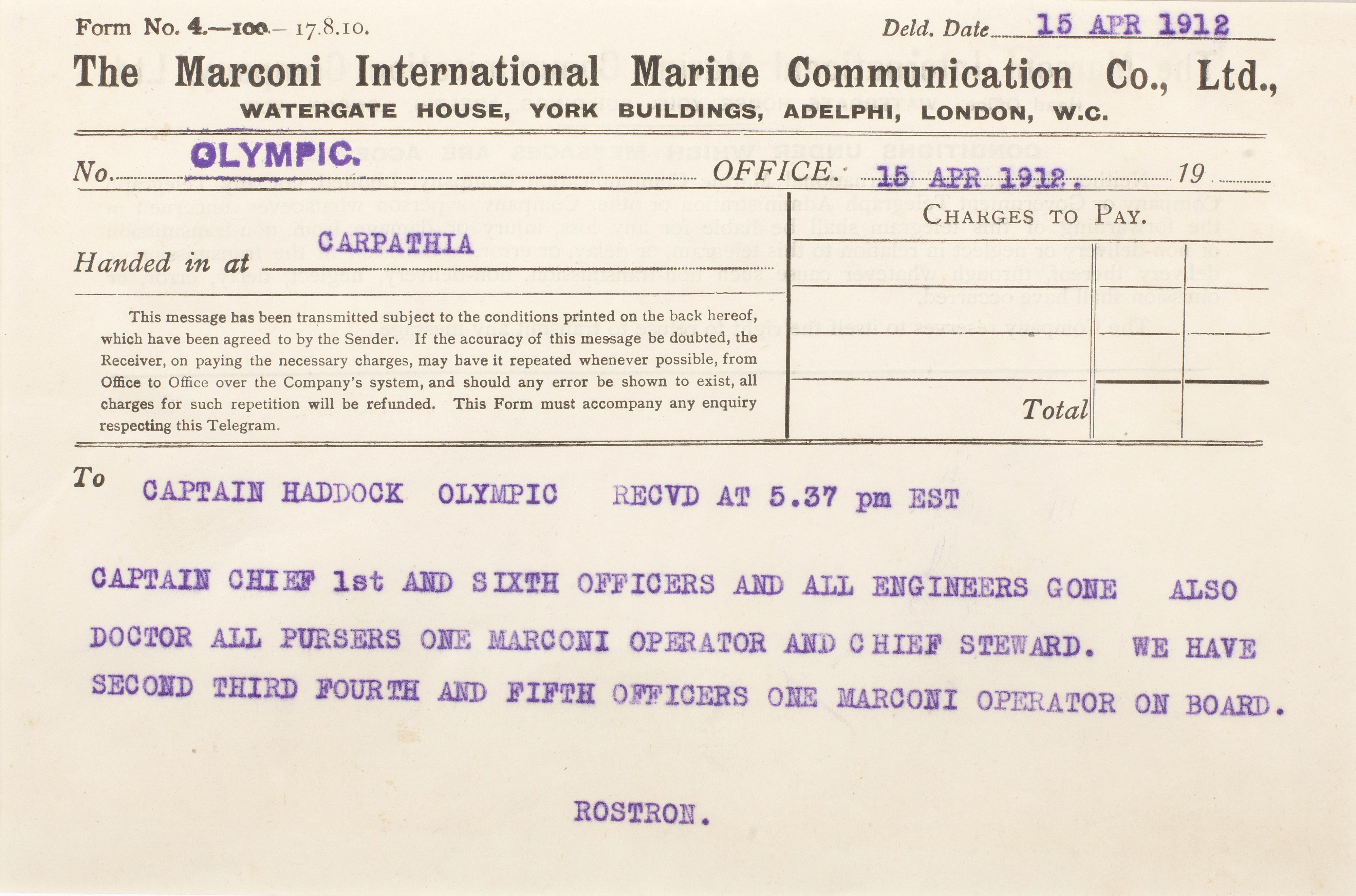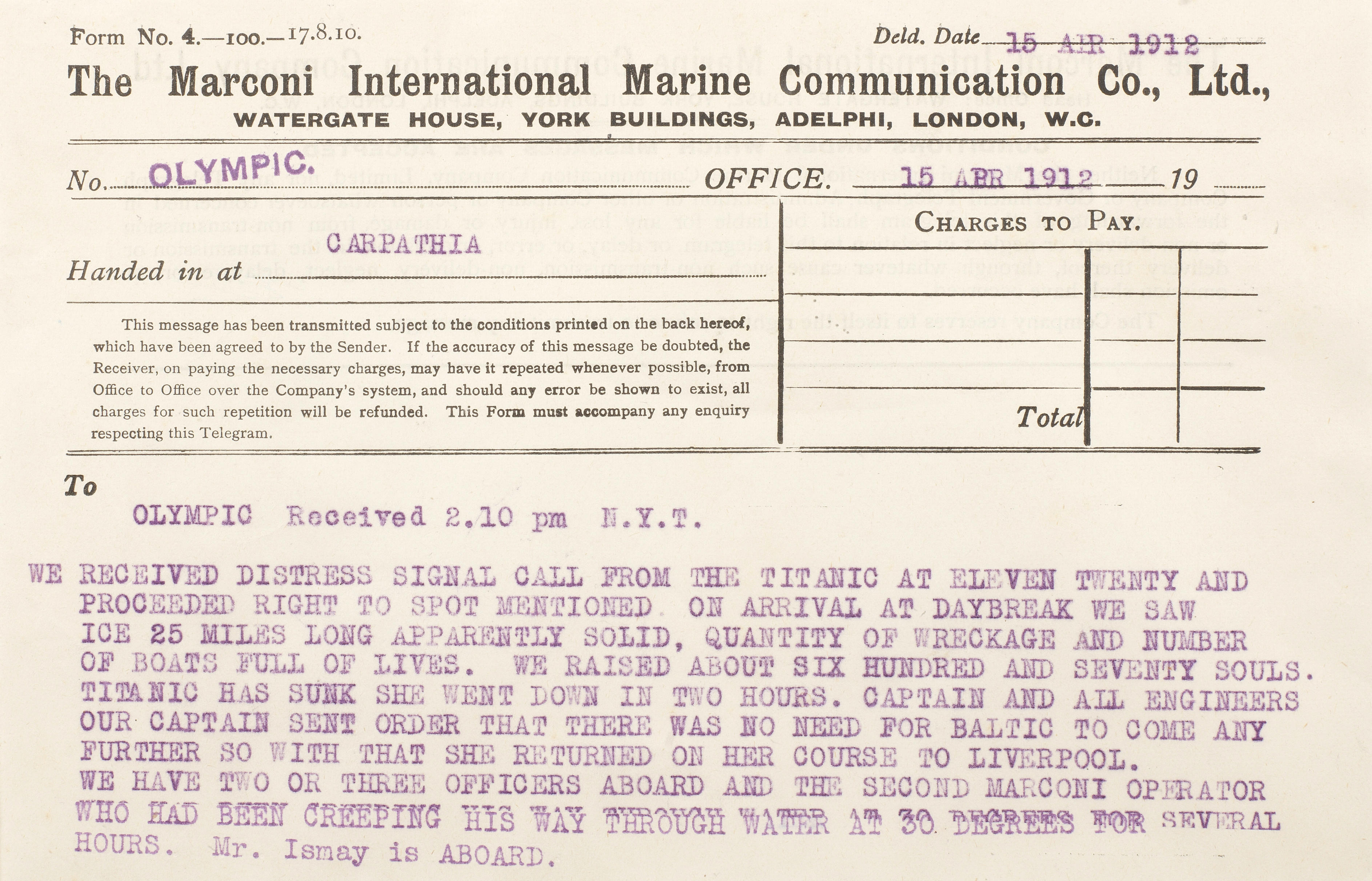R.M.S. CARPATHIA TITANIC-RELATED SALVAGE ITEMS The following four lots consist of items salvaged from the R.M.S. Carpathia and were involved in Carpathia's rescue of over 700 survivors of the Titanic disaster on the morning of 15th April, 1912. The Carpathia was a Cunard Line transatlantic passenger steamship built by Swan Hunter & Wigham Richardson in Wallsend, Liverpool, Tyne and Wear in England in 1903. She is best known as the ship which rescued all of Titanic's survivors. In the early morning of 15th April, 1912 the Carpathia's radio operator, Harold Cottam, received a message from Titanic that it had struck an iceberg. After bringing the message to the ship's master, Captain Arthur Rostron, Rostron took immediate steps to steam to Titanic's reported position calling on additional stokers to make all possible speed. He ordered the ship's heating and hot water cut off to provide as much steam as possible to the engines. After navigating around an ice field, Carpathia reached Titanic's position at about 4:00 A.M., a little more than an hour and a half after Titanic went down. Carpathia arrived in New York on 18th April, 1912 where Titanic's survivors disembarked and the Carpathia resumed its regular voyage to the Mediterranean. After being pressed into service during World War I by the British Admiralty, Carpathia was sunk on 17th July, 1918 by three torpedoes fired by U-55 of the German Imperial Navy around 120 miles west of Fastnet. Carpathia was discovered lying in an upright position at a depth of about 500 feet of water 120 miles west of Fastnet, Ireland. Exploring it posed some difficulty. While there are rare cases of commercial divers briefly reaching depths of 1000 feet, 500 feet represents the more realistic limit of human tolerance for deep sea divers, imposing a heavy decompression penalty of five hours. Numerous dives were made in August and September 2007 to recover Carpathia's artifacts from the debris field. Over 90 artifacts were recovered including some involved in Carpathia's rescue of Titanic's survivors. Such are the artifacts offered here. The following five lots are unparalleled: An engine order telegraph from Carpathia's bridge used to signal the engine room; a lamp which would have lighted the way for survivors in the dark; a port hole which still opens and closes; and a six-inch wide floor tile. These lots have seen no equal. In terms of historical importance they can be equated with such items as Wallace Hartley's violin and Titanic's crow's nest bell. The financial investment, the Herculean effort and the risk to human life involved in recovering these artifacts from the ocean floor is a testament to how important it was to preserve the history and tangible evidence of Carpathia's rescue of Titanic's survivors. None of these items have ever been on public display. But future possibilities are endless. The following lots have been conserved, but not restored. You see them as they were on the ocean floor. A collection which includes Carpathia's rescue-related engine order telegraph, porthole, deck lamp, or floor tile would be worthy of world class recognition. Every lot is accompanied by a frame-worthy original Certificate of Authenticity signed by expedition leader P.H. Nargeolet who also led several expeditions to Titanic's wreck site. Each lot bears a later added unobtrusive inked-in accession number. For a more detailed condition report please refer to the images, or telephone during business hours. R.M.S. Titanic/Ocean Liner/R.M.S. Carpathia, Salvaged Engine Order Telegraph on Base Today, modern vessels have a throttle on the bridge for the direct control of the engines without any involvement of engine room personnel. In Titanic's time, bridge personnel would have to move the pointer on the telegraph to the desired speed. This would trigger an "alarm" bell in the engine room which signalled an incoming engine order from the bridge. In the case of the rescue of the Titanic's surviving passenge
R.M.S. CARPATHIA TITANIC-RELATED SALVAGE ITEMS The following four lots consist of items salvaged from the R.M.S. Carpathia and were involved in Carpathia's rescue of over 700 survivors of the Titanic disaster on the morning of 15th April, 1912. The Carpathia was a Cunard Line transatlantic passenger steamship built by Swan Hunter & Wigham Richardson in Wallsend, Liverpool, Tyne and Wear in England in 1903. She is best known as the ship which rescued all of Titanic's survivors. In the early morning of 15th April, 1912 the Carpathia's radio operator, Harold Cottam, received a message from Titanic that it had struck an iceberg. After bringing the message to the ship's master, Captain Arthur Rostron, Rostron took immediate steps to steam to Titanic's reported position calling on additional stokers to make all possible speed. He ordered the ship's heating and hot water cut off to provide as much steam as possible to the engines. After navigating around an ice field, Carpathia reached Titanic's position at about 4:00 A.M., a little more than an hour and a half after Titanic went down. Carpathia arrived in New York on 18th April, 1912 where Titanic's survivors disembarked and the Carpathia resumed its regular voyage to the Mediterranean. After being pressed into service during World War I by the British Admiralty, Carpathia was sunk on 17th July, 1918 by three torpedoes fired by U-55 of the German Imperial Navy around 120 miles west of Fastnet. Carpathia was discovered lying in an upright position at a depth of about 500 feet of water 120 miles west of Fastnet, Ireland. Exploring it posed some difficulty. While there are rare cases of commercial divers briefly reaching depths of 1000 feet, 500 feet represents the more realistic limit of human tolerance for deep sea divers, imposing a heavy decompression penalty of five hours. Numerous dives were made in August and September 2007 to recover Carpathia's artifacts from the debris field. Over 90 artifacts were recovered including some involved in Carpathia's rescue of Titanic's survivors. Such are the artifacts offered here. The following five lots are unparalleled: An engine order telegraph from Carpathia's bridge used to signal the engine room; a lamp which would have lighted the way for survivors in the dark; a port hole which still opens and closes; and a six-inch wide floor tile. These lots have seen no equal. In terms of historical importance they can be equated with such items as Wallace Hartley's violin and Titanic's crow's nest bell. The financial investment, the Herculean effort and the risk to human life involved in recovering these artifacts from the ocean floor is a testament to how important it was to preserve the history and tangible evidence of Carpathia's rescue of Titanic's survivors. None of these items have ever been on public display. But future possibilities are endless. The following lots have been conserved, but not restored. You see them as they were on the ocean floor. A collection which includes Carpathia's rescue-related engine order telegraph, porthole, deck lamp, or floor tile would be worthy of world class recognition. Every lot is accompanied by a frame-worthy original Certificate of Authenticity signed by expedition leader P.H. Nargeolet who also led several expeditions to Titanic's wreck site. Each lot bears a later added unobtrusive inked-in accession number. For a more detailed condition report please refer to the images, or telephone during business hours. R.M.S. Titanic/Ocean Liner/R.M.S. Carpathia, Salvaged Engine Order Telegraph on Base Today, modern vessels have a throttle on the bridge for the direct control of the engines without any involvement of engine room personnel. In Titanic's time, bridge personnel would have to move the pointer on the telegraph to the desired speed. This would trigger an "alarm" bell in the engine room which signalled an incoming engine order from the bridge. In the case of the rescue of the Titanic's surviving passenge















Testen Sie LotSearch und seine Premium-Features 7 Tage - ohne Kosten!
Lassen Sie sich automatisch über neue Objekte in kommenden Auktionen benachrichtigen.
Suchauftrag anlegen